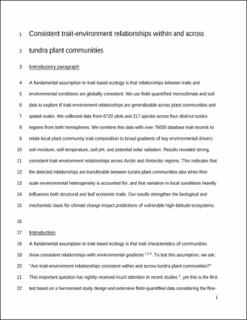| dc.contributor.author | Kemppinen, Julia | |
| dc.contributor.author | Niittynen, Pekka | |
| dc.contributor.author | le Roux, Peter C. | |
| dc.contributor.author | Momberg, Mia | |
| dc.contributor.author | Happonen, Konsta | |
| dc.contributor.author | Aalto, Juha | |
| dc.contributor.author | Rautakoski, Helena | |
| dc.contributor.author | Enquist, Brian J. | |
| dc.contributor.author | Vandvik, Vigdis | |
| dc.contributor.author | Rechsteiner, Aud Helen Halbritter | |
| dc.contributor.author | Maitner, Brian S. | |
| dc.contributor.author | Luoto, Miska | |
| dc.date.accessioned | 2021-12-14T08:11:57Z | |
| dc.date.available | 2021-12-14T08:11:57Z | |
| dc.date.created | 2021-09-07T16:02:10Z | |
| dc.date.issued | 2021 | |
| dc.identifier.issn | 2397-334X | |
| dc.identifier.uri | https://hdl.handle.net/11250/2834081 | |
| dc.description.abstract | A fundamental assumption in trait-based ecology is that relationships between traits and environmental conditions are globally consistent. We use field-quantified microclimate and soil data to explore if trait–environment relationships are generalizable across plant communities and spatial scales. We collected data from 6,720 plots and 217 species across four distinct tundra regions from both hemispheres. We combined these data with over 76,000 database trait records to relate local plant community trait composition to broad gradients of key environmental drivers: soil moisture, soil temperature, soil pH and potential solar radiation. Results revealed strong, consistent trait–environment relationships across Arctic and Antarctic regions. This indicates that the detected relationships are transferable between tundra plant communities also when fine-scale environmental heterogeneity is accounted for, and that variation in local conditions heavily influences both structural and leaf economic traits. Our results strengthen the biological and mechanistic basis for climate change impact predictions of vulnerable high-latitude ecosystems. | en_US |
| dc.language.iso | eng | en_US |
| dc.publisher | Springer Nature | en_US |
| dc.title | Consistent trait-environment relationships within and across tundra plant communities | en_US |
| dc.type | Journal article | en_US |
| dc.type | Peer reviewed | en_US |
| dc.description.version | acceptedVersion | en_US |
| dc.rights.holder | Copyright 2021 the authors | en_US |
| cristin.ispublished | true | |
| cristin.fulltext | postprint | |
| cristin.qualitycode | 2 | |
| dc.identifier.doi | 10.1038/s41559-021-01396-1 | |
| dc.identifier.cristin | 1932144 | |
| dc.source.journal | Nature Ecology and Evolution | en_US |
| dc.source.pagenumber | 458-467 | en_US |
| dc.relation.project | Norges forskningsråd: 287784 | en_US |
| dc.identifier.citation | Nature Ecology and Evolution. 2021, 5, 458-467. | en_US |
| dc.source.volume | 5 | en_US |
